|
Figure 2-1-I
Light waves entering the gravity field of the Earth (= the area within the dotted circle; in reality the gravity field of the Earth is oval, i.e. smaller towards the Sun; the area outside the dotted circle, where the light waves are drawn, is the gravity field of the Sun). [May 2003: Whether or not light wave C too is dragged with the Earth is an open question. I think so and this needs an alternative explanation for stellar aberration, which you can find in 2-2. Other dissident scientists, like Hatch4, say: light wave C is not dragged with the Earth because we have such thing as stellar aberration.
Van Flandern5 writes that stellar aberration is entirely due to: 1. the finite speed of light, and 2. the much higher speed of gravity (like 1010 c). I have a different explanation for stellar aberration than Van Flandern, but I agree with him that the speed of gravity may be much faster than the speed of light, see 3-1. End May 2003] Figure 2-1-II
Illustration of gravity is the ether by people walking over a moving plate. Perhaps the best way to understand the adjustment of light waves is (see Fig. 2-1-II): imagine a circular horizontal plate moving slowly across the floor. You walk over the plate (after coming from the floor) and you keep walking the same tempo (first 5 km/hour relative to the floor, then 5 km/hour relative to the plate). Persons A, B and C will change speed relative to observers on the plate and on the floor the moment they step on the plate.
As soon as the light waves A, B and C (see Fig. 2-1-I) are in the gravity field of the Earth their velocity is 300,000 km/s relative to the gravity field of the Earth. Before the light waves entered the gravity field of the Earth in QA, QB and QC, their velocities were 300,000 km/s relative to the gravity field of the Sun. Of course: the Earth turns around its axis and so things are more complicated. Also: hence all objects move on bended paths (like our Earth around the Sun and our Sun in the Galaxy) the path of a light wave is bend for someone who is not in the same gravity field as the light wave.
In December 2001, 20 months after I had thought up gravity as the ether, I discovered that someone else had an idea in 1990 that was the same in a certain respect:
J.L. Gaasenbeek14 thought up electromagnetic frames of references (EFORS) to which photons adjust themselves. [May 2003: I know now that tens or perhaps hundreds of people thought up photons–adjusting–to–Earth ideas. You may wonder why in January 2002 (when I opened this website) I had only found three websites with alternative ideas: the photon-adjusting-to-Earth website by Gaasenbeek14 (2-1), Gelman's website on the subject of pushing gravity15 (3-2) and the website with Reber's infinite universe16 (4-1), where there are and were so many websites (and books) by dissidents to be found on the internet. Friends of me found the websites. In May 2002 I bought a modern computer myself and from that moment I could go on the internet myself. End May 2003] For a good understanding of ether it may be important to know a little more about the Great Dilemma, i.e. how scientists originated the Great Dilemma in the 18th and 19th century: because of too much awe for one of the founders of modern astronomy, James Bradley.
In 1727 James Bradley, an Englishman, noticed that certain stars appeared to be in a different direction in the sky when looked at 6 months later10 (see Fig. 2-1-III). 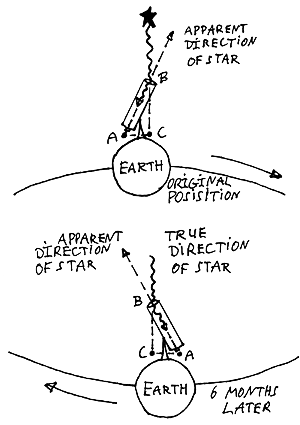 Figure 2-1-III
Explanation of stellar aberration by Bradley (this picture has been taken from Coleman's book10) Bradley called the phenomenon aberration and explained it as follows: while a light wave travels from B to C with 300,000 km/s the telescope moves from A to C with 30 km/s. In Fig. 2-1-IV this is pictured in a slightly different way.
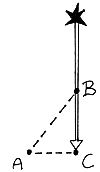 Figure 2-1-IV
Explanation of stellar aberration as in today astronomy and physics: the light wave travels from B to C while the telescope moves from A to C. Scientists in the 18th and 19th century thought that the same explanation should go for a star with light shining not exactly perpendicular to the direction of the Earth's velocity, like it is shown in Fig. 2-1-V: when the light travelled from B to C with 300,000 km/s the telescope would move from A to C with 30 km/s.
 Figure 2-1-V
Stellar aberration as it was seen in the 18th and 19th century (today it is still the same with the exception that something is added: length contraction for the horizontal component). And, finally, there could be the situation where AC and BC are on the same line (like in Fig. 2-1-VI): again scientists reasoned that while the light wave travelled from B to C the telescope would move from A to C.
Figure 2-1-VI
Stellar aberration as it was expected in the 18th and 19th century with the Earth moving towards a light wave (from A to C while the light goes from B to C). If the Earth would have moved in the same direction as the light wave then it would have been as in Fig. 2-1-VII: while the light wave travelled from B to C the telescope would move from A to C.
Figure 2-1-VII
Stellar aberration as it was expected in the 18th and 19th century with the Earth moving in the same direction as a light wave (from A to C while the light goes from B to C). This is how scientists thought in the 18th and 19th century because they not only took Bradley's historic measurement of stellar aberration for the truth (= the fact that certain stars appear to be in a different direction in the sky when looked at 6 months later) but also Bradley's (historic) explanation of stellar aberration (= while the light travels from B to C the telescope moves from A to C as in the aforementioned figures).
Thus scientists reasoned that things were as it is shown in Fig. 2-1-VI and 2-1-VII and many efforts were made to measure this. But they didn't speak about stellar aberration in the case of figures 2-1-VI and 2-1-VII, instead of stellar aberration it was called: the out-of-focus effect. I will now discuss the out-of-focus effect, duplicating the reasoning in the 18th and 19th century (which is the basically the same as what I explained with Fig. 2-1-VI and Fig. 2-1-VII).
This “18th and 19th century reasoning” has been taken from professor Coleman's book10: Assume we have a telescope set up on the Earth. We focus it on a star which is in the direction the Earth is travelling in its orbit. Two of the light beams from the star have just entered the telescope in Fig. 2-1-VIIIa. 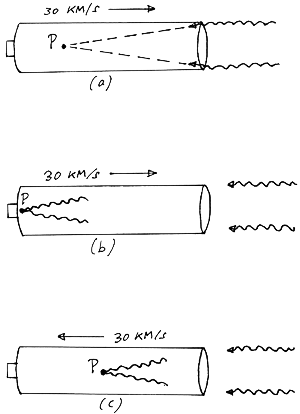 Figure 2-1-VIII
The expected out-of-focus effect (this picture has been taken from Coleman's book10). These beams have been bent by the telescope lens so that they will come to focus at point P, which is a point in the space within the telescope.
Now since the telescope and observer are moving to the right with a velocity of 30 km/s, the observer's eyes will arrive at point P at the same time the light beams do in Fig. 2-1-VIIIb, and the observer will see the star in focus. But now suppose the astronomer looks at the same star 6 months later and does not change the focus. The situation will be entirely different, since the Earth will be on the other side of its orbit. Whereas before it was travelling towards the star with 30 km/s, it will now be travelling away from it, with the same velocity. What was expected to happen in the 18th and 19th century is shown in Fig. 2-1-VIIIc. Since the telescope and observer are now running away from the incoming light wave, the observer's eye will no longer be at point P when the light beams arrive there, and as a consequence the observer will now see the star out of focus. Scientists in the 18th and 19th century expected a telescope that was originally in focus on a distant star would be out of focus six months later. So this effect was looked for but was never observed.
Scientists did not measure the expected out-of-focus effect. Expectance based on Bradley's explanation of stellar aberration.
But instead of questioning Bradley's explanation and thus solving the problem they entered the era of the Great Dilemma, they couldn't grasp that the great man who discovered the aberration phenomenon could have made a mistake explaining the phenomenon, questioning Bradley would have been heretical. Thus frustration started and became even bigger when Michelson and Morley did their famous experiment in 1881. Michelson and Morley tried to end the confusion with experiments that had light running along the direction of the Earth (in its orbit around the Sun) and light running perpendicular to the direction of the Earth10. They found that light always ran over the surface of the Earth in a way that is totally independent from the direction of the Earth in its orbit around the Sun. The Michelson-Morley experiment did not show that the velocity of light is always constant relative to an observer no matter the velocity of the observer. What the Michelson-Morley experiment showed was: the velocity of light on Earth (or rather: close to the Earth) is always constant relative to the Earth.
In 1905 Albert Einstein presented a model that had incorporated Bradley's mistake too, but the model was worthwhile because the 2 basic postulates of the theory of special relativity could be used as a starting point for a number of equations and thus calculations could be made with it and by now the model is the most “proven” one we have, like the Sun-around-Earth model was before Copernicus came by.
The formula's derived from Einstein's postulates are based on velocity differences of moving objects. With gravity is the ether one also gets formula's based on velocity differences, therefore the gravity is the ether hypothesis brings the same type of formula's. Observations that are explained with the theory of relativity can be explained with gravity is the ether too, see 2-2. [May 2003: Unlike me Assis2 and Ghosh3 and many others4, 5, 11 have derived formula's with which they can calculate all experimental facts that “prove” relativity. Experimental facts like: gravitational redshift, advance of the perihelion of Mercury, bending of light, “time delay” of light, solar oblateness, etc. End May 2003] Einstein used the Fitzgerald-Lorentz contraction10 (he turned the Fitzgerald contraction into length contraction, which is a little different) to explain the contradiction between Bradley's explanation of stellar aberration and the not measured out-of-focus effect. Bradley's explanation of stellar aberration and not measuring the out-of-focus effect can not coexist, seeing that is (solving) the heart of the problem.
|
